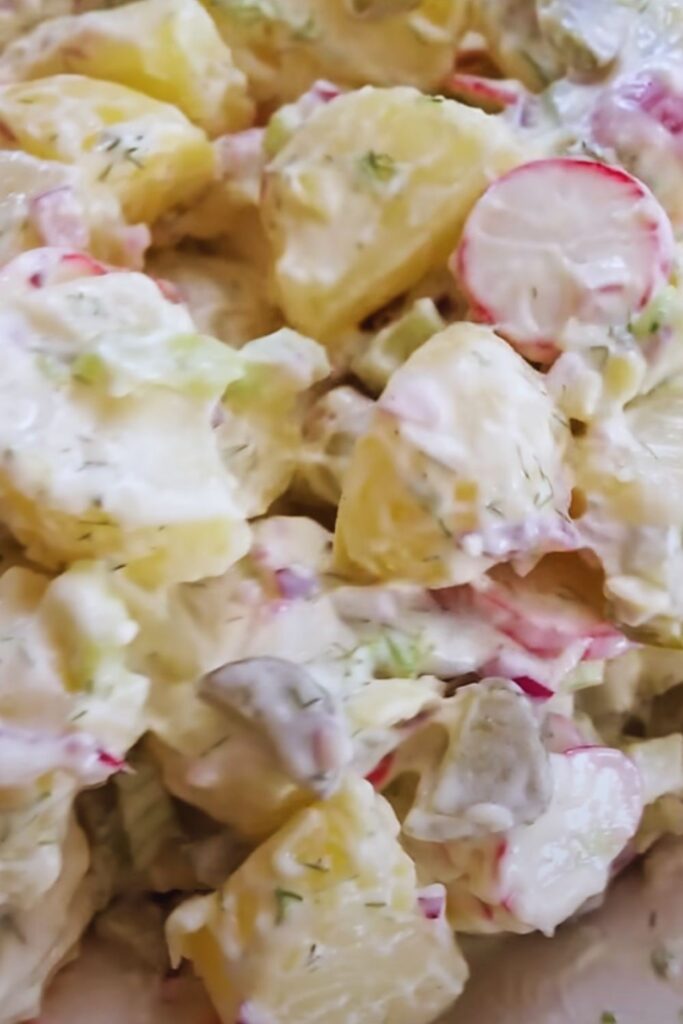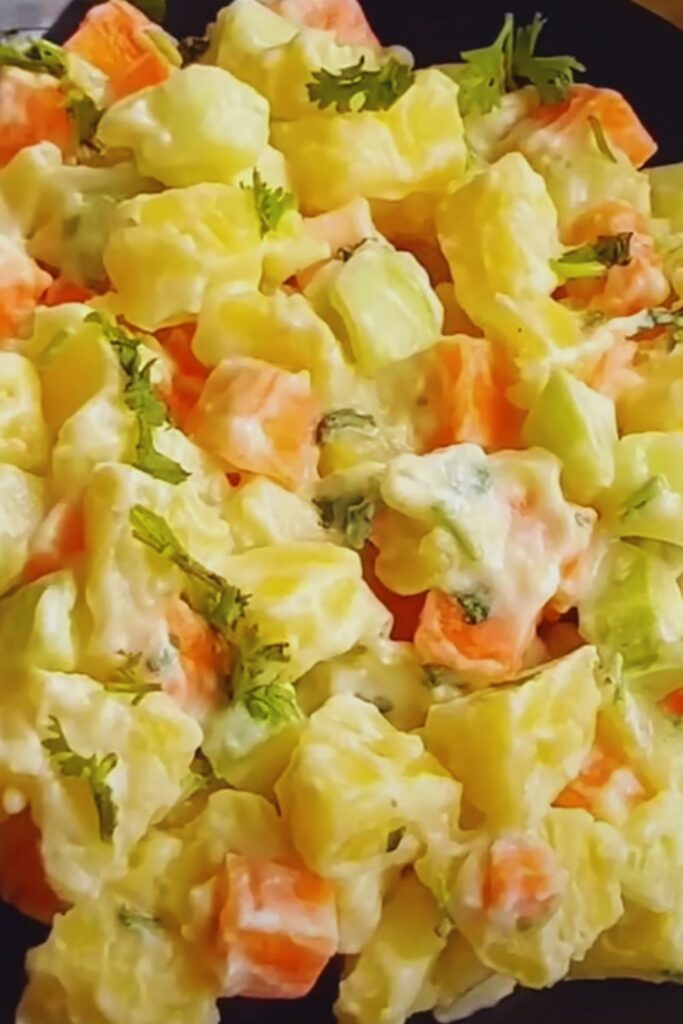When I first encountered Turkish potato salad, or “patates salatası” as it’s known in Turkey, I was immediately struck by its vibrant flavors and refreshing simplicity. Unlike the mayonnaise-heavy American versions I grew up with, this Mediterranean delight balances tangy, savory, and fresh notes in perfect harmony. Today, I’m excited to share my favorite recipe for this versatile dish that has become a staple in my kitchen for family gatherings, picnics, and weeknight meals alike.
The Cultural Significance of Patates Salatası
In Turkey, potato salad isn’t just a side dish—it’s a celebration of fresh ingredients and culinary tradition. During my travels through Istanbul and the Turkish countryside, I discovered that this humble dish appears on tables from casual family meals to elaborate celebrations. What makes Turkish potato salad special is its emphasis on olive oil rather than mayonnaise, creating a lighter profile that perfectly complements the Mediterranean diet.
The dish reflects Turkey’s agricultural bounty and the country’s position as a crossroads between Europe, Asia, and the Middle East. Each region adds its own subtle variations—coastal areas might include more herbs and lemon, while inland recipes often feature more robust onion flavors and sometimes hot peppers for a gentle kick.
Essential Ingredients for Authentic Patates Salatası
The beauty of Turkish potato salad lies in its simplicity. While variations exist across different regions, these core ingredients form the foundation of an authentic patates salatası:
| Ingredient | Quantity | Notes |
|---|---|---|
| Yukon gold potatoes | 2 pounds (about 6-8 medium potatoes) | Preferred for their buttery flavor and waxy texture that holds shape when cooked |
| Extra virgin olive oil | 1/3 cup | Use the highest quality you can find for best flavor |
| Fresh lemon juice | 3-4 tablespoons (about 1-2 lemons) | Freshly squeezed provides the brightest flavor |
| Red onion | 1 medium | Thinly sliced or finely diced depending on preference |
| Fresh parsley | 1/2 cup | Finely chopped, flat-leaf variety preferred |
| Fresh dill | 1/4 cup | Finely chopped, adds distinctive Mediterranean flavor |
| Scallions | 3-4 | Thinly sliced, both white and green parts |
| Sea salt | 1 teaspoon | Adjust to taste |
| Black pepper | 1/2 teaspoon | Freshly ground provides best flavor |
| Optional additions | To taste | Hard-boiled eggs, capers, olives, sumac, or Aleppo pepper |
Traditional vs. Modern Interpretations
While respecting tradition, I’ve found that patates salatası welcomes thoughtful adaptation. Here’s how the classic version compares to modern variations you might encounter:
| Feature | Traditional Approach | Modern Interpretations |
|---|---|---|
| Base | Always olive oil-based | Sometimes includes yogurt for creaminess while maintaining lightness |
| Potatoes | Simple boiled potatoes | May include roasted potatoes for deeper flavor |
| Herbs | Primarily parsley and sometimes dill | Expanded herb profiles including mint, oregano, or cilantro |
| Acid component | Lemon juice | Sometimes apple cider vinegar or a combination of acids |
| Spices | Minimal—mainly salt and pepper | May include sumac, Aleppo pepper, or za’atar for complex flavor profiles |
| Vegetables | Onions and sometimes tomatoes | Often includes cucumber, bell peppers, or other seasonal vegetables |
| Texture elements | Generally soft with crunchy onions | May include nuts like walnuts or pine nuts for additional texture |
Step-by-Step Preparation Guide
I’ve refined this method over years of making patates salatası, finding the perfect balance between authenticity and practicality for home cooks.

Preparing the Potatoes
- Select medium-sized Yukon gold potatoes for their ideal texture and flavor.
- Wash the potatoes thoroughly but leave the skins on—they contain nutrients and help the potatoes hold their shape.
- Place potatoes in a large pot and cover with cold water, adding 1 tablespoon of salt.
- Bring to a gentle boil over medium-high heat, then reduce to a simmer.
- Cook until the potatoes are tender when pierced with a fork—approximately 15-20 minutes depending on size.
- Drain thoroughly and allow to cool until they’re comfortable to handle, but still warm.
- Peel the potatoes if desired (though I often leave the nutritious skins on).
- Cut into even 1/2-inch cubes or slices, depending on your preference.
Preparing the Dressing and Aromatics
While the potatoes are cooling slightly, I prepare the vibrant dressing that gives patates salatası its distinctive character:
- Thinly slice or finely dice the red onion (depending on whether you prefer more texture or subtle integration).
- If using raw onion feels too pungent, soak the slices in cold water for 10-15 minutes, then drain and pat dry to mellow the flavor.
- Finely chop the fresh parsley and dill, ensuring they’re completely dry to prevent diluting the dressing.
- Slice the scallions into thin rounds, using both the white and green parts.
- In a small bowl, whisk together the olive oil and lemon juice until emulsified.
- Season the dressing with salt and freshly ground black pepper to taste.
Assembling the Salad
The key to a perfect patates salatası is combining the ingredients while the potatoes are still warm enough to absorb the dressing flavors but cool enough not to wilt the herbs:
- Place the warm potato pieces in a large bowl.
- Pour half of the dressing over the potatoes and gently toss to coat evenly.
- Add the onions, parsley, dill, and scallions to the bowl.
- Drizzle the remaining dressing over everything.
- Using a large spoon or spatula, gently fold the ingredients together, being careful not to break the potato pieces.
- Taste and adjust seasoning as needed, adding more salt, pepper, or lemon juice to achieve your preferred flavor balance.
Resting and Serving
For the best flavor development:
- Allow the salad to rest at room temperature for at least 30 minutes before serving, permitting the flavors to meld.
- For even better results, refrigerate for 2-4 hours, then bring back to room temperature before serving.
- Just before serving, gently toss once more and garnish with additional fresh herbs.
- A light drizzle of your best olive oil and a final pinch of flaky sea salt adds the perfect finishing touch.

Regional Variations Across Turkey
During my culinary explorations throughout Turkey, I discovered fascinating regional adaptations of this beloved dish:
| Region | Distinctive Features | Special Ingredients |
|---|---|---|
| Aegean Coast | Lighter, more herb-forward | Abundant dill, sometimes mint, more lemon juice |
| Black Sea Region | Heartier, more substantial | May include corn, anchovies, or pickled vegetables |
| Central Anatolia | Robust and warming | Often includes hot peppers, sometimes garlic, heartier use of onions |
| Mediterranean Region | Fresh and bright | May include capers, olives, sometimes a hint of oregano |
| Eastern Turkey | Bold and aromatic | May feature sumac, pomegranate molasses, or walnut accents |
Nutritional Benefits
What I love about patates salatası is not just its delicious taste but also its nutritional profile, especially compared to mayonnaise-based alternatives:
| Nutrient | Benefit | Source in the Recipe |
|---|---|---|
| Complex carbohydrates | Sustained energy | Potatoes |
| Heart-healthy fats | Cardiovascular benefits | Extra virgin olive oil |
| Vitamin C | Immune support, collagen production | Potatoes, lemon juice, fresh herbs |
| Potassium | Electrolyte balance, muscle function | Potatoes |
| Antioxidants | Cell protection, anti-inflammatory | Olive oil, herbs, onions |
| Fiber | Digestive health, satiety | Potato skins (if left on), vegetables |
| Prebiotics | Gut health | Onions, garlic (if used) |
| Vitamin K | Blood clotting, bone health | Fresh herbs, especially parsley |
Serving Suggestions
Patates salatası is incredibly versatile and pairs beautifully with numerous main dishes. Here are my favorite ways to enjoy it:
- Alongside grilled köfte (Turkish meatballs) or kebabs
- With grilled fish, especially mackerel or sea bass
- As part of a mezze spread with hummus, baba ganoush, and fresh pita
- Nestled beside stuffed vegetables like dolmas (stuffed grape leaves)
- With simple roasted chicken seasoned with sumac and lemon
- As a light lunch topped with a soft-boiled egg
- In a Mediterranean-inspired Buddha bowl with falafel and roasted vegetables
- Stuffed inside a wrap with grilled vegetables and yogurt sauce
- As an accompaniment to Turkish börek (savory pastries)
- With a simple tomato and cucumber salad for a light summer meal

Storage and Make-Ahead Tips
I’ve found these methods work best for maintaining the freshness and flavor of patates salatası:
- The salad can be prepared up to 2 days ahead and stored in an airtight container in the refrigerator.
- If making ahead, consider reserving some of the fresh herbs to add just before serving for the brightest color and flavor.
- The flavors actually improve after a few hours of refrigeration as they have time to meld.
- If the salad seems dry after refrigeration, drizzle with a small amount of additional olive oil and lemon juice to refresh it.
- Always bring the salad to room temperature before serving for the best flavor experience.
- While freezing is not recommended as it damages the texture of the potatoes, the salad keeps beautifully in the refrigerator for 3-4 days.
Troubleshooting Common Issues
Even experienced cooks sometimes encounter challenges with potato salads. Here are solutions to common issues I’ve faced when making patates salatası:
| Problem | Cause | Solution |
|---|---|---|
| Mushy potatoes | Overcooked or cut when too hot | Cook just until fork-tender; cool slightly before cutting |
| Bland flavor | Insufficient seasoning or not enough resting time | Season potatoes while warm; allow adequate time for flavor development |
| Too dry | Not enough dressing or absorption issues | Dress potatoes while still warm; add extra olive oil if needed after resting |
| Too sharp onion flavor | Varieties differ in intensity | Soak onions in cold water for 10-15 minutes before adding |
| Discolored herbs | Wilting from heat or acid | Add herbs after potatoes have cooled slightly; reserve some for garnish |
| Watery salad | Inadequate draining of potatoes | Ensure potatoes are thoroughly drained; consider patting dry |
| Unbalanced flavor | Improper acid-to-oil ratio | Adjust lemon juice and olive oil to achieve desired balance |
| Uneven seasoning | Poor distribution technique | Season in layers and fold gently but thoroughly |
Frequently Asked Questions
Can I use different types of potatoes for Turkish potato salad? Yes, you can, though waxy varieties like Yukon Gold or red potatoes hold their shape best. Russets tend to break down more easily, which might change the texture of your salad.
Is it authentic to add yogurt to patates salatası? While the most traditional versions are olive oil-based, some contemporary Turkish households do add a small amount of yogurt for creaminess while maintaining the distinctively Mediterranean character.
How can I make this recipe vegan? The classic recipe is naturally vegan! Just ensure any optional additions you choose (like yogurt) are plant-based if needed.
Can I prepare patates salatası in advance for a party? Absolutely! In fact, the flavors improve after a few hours of resting. I recommend making it up to a day ahead and bringing it to room temperature before serving.
What’s the best way to prevent the potatoes from getting mushy? Start potatoes in cold water, simmer gently rather than boiling vigorously, and test frequently with a fork for doneness. Immediately drain and allow them to cool slightly before cutting.
How can I add more protein to make this a complete meal? Hard-boiled eggs are a traditional addition. You could also serve it with grilled chicken, fish, or chickpeas for a heartier option.
Is sumac traditional in patates salatası? While not universal, sumac is used in some regional variations, particularly in eastern Turkey. Its tangy, lemony flavor complements the dish beautifully.
How spicy is authentic Turkish potato salad? Most versions are not spicy at all, though some regional variations might include a mild pepper. Feel free to add Aleppo pepper flakes for a gentle warmth if desired.
Can I use dried herbs instead of fresh? Fresh herbs are strongly preferred for authentic flavor and texture. If you must use dried, use about one-third the amount and reconstitute them in a little warm water first.
What makes Turkish potato salad different from American potato salad? The primary difference is the dressing—Turkish versions use olive oil and lemon juice rather than mayonnaise, resulting in a lighter, more refreshing profile with Mediterranean flavors.
Personal Reflection
I remember the first time I tasted authentic patates salatası, sitting at a small family-run restaurant in Istanbul’s Kadıköy neighborhood. The bright flavors and simple ingredients spoke of centuries of culinary wisdom, using what was fresh and available to create something truly special. What struck me most was how a dish so humble could taste so vibrant—each forkful offering a perfect balance of tangy, herbaceous, and earthy notes.
Since that memorable meal, I’ve made this salad countless times in my own kitchen, each preparation connecting me to that moment and to Turkey’s rich culinary heritage. I find there’s something deeply satisfying about transforming a few simple ingredients into a dish that consistently delights family and friends.
Whether you’re looking to expand your international recipe collection or simply seeking a lighter alternative to mayo-based potato salads, I hope this patates salatası becomes a beloved addition to your cooking repertoire. Its versatility, nutritional benefits, and exquisite flavor make it far more than just a side dish—it’s a celebration of the Mediterranean approach to food, where quality ingredients, thoughtful preparation, and shared enjoyment create something truly special.




